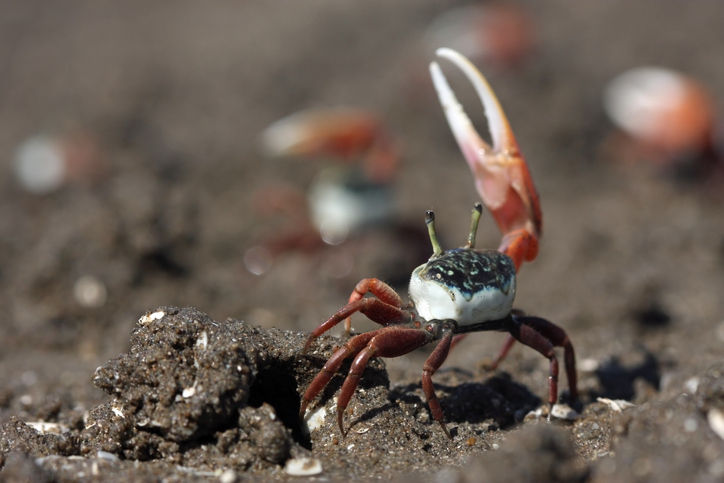Fiddler crab’s eyes inspire researchers to develop amphibious artificial vision
Scientists have managed to create a panoramic amphibious vision system that works equally well underwater and on land.

- A new kind of artificial vision has been created that works well underwater and on land
- It is based on how the fiddler crab’s eyes work
- The fiddler crab was considered a good proxy as it is a semi-aquatic creature
Inspired by the way a Fiddler crab’s eye works Scientits have managed to develop a form of a novel artificial vision that works equally well on land and in water.
Researchers from the Gwangju Institute of Science and Technology (GIST), and Seoul National University in Korea managed to develop the artificial vision, according to a research published in the journal Nature Electronics.
“This is a spectacular piece of optical engineering and non-planar imaging, combining aspects of bio-inspired design and advanced flexible electronics to achieve unique capabilities unavailable in conventional cameras,” said Professors at Northwestern University.
“Potential uses span from population surveillance to environmental monitoring.”
Our hardware sight has enabled a wide range of applications, including object identification, crop monitoring, and self-driving cars.
But unlike living creatures, artificial vision systems can’t just naturally grow in their natural environments.
For this reason, the new technology is capable of working in both aquatic and terrestrial environments.
The fiddler crab, a semi-terrestrial species known affectionately as the “calling crab” (as it appears to be beckoning with its huge claws), has amphibious imaging ability and an extremely wide field of view.

The new artificial eye, which resembles a round, generally unremarkable, little black ball, is able to discern light through a combination of components.
The researchers used a flexible photodiode array with comb-shaped patterns, an array of flat microlenses with a graded refractive index profile, and a 3D spherical structure.
Because of this setup, no matter what the refractive index of the area around the image sensor was, light beams from various sources would always converge there.
The system is able to provide constant image quality and an almost 360-degree field of view in both terrestrial and aquatic situations.
The amphibious and panoramic imaging capabilities were evaluated in in-air and in-water studies by imaging five objects at various distances and directions.
Meaning: Unlike earlier systems, it could see in two different domains—underwater and on land.
Inspiring fiddler crabs eye
Regarding fiddler crabs, there is more to the story than first appears.
Their powerful, distinctive visual system, which has evolved from living both underwater and on land, is hidden under their enormous claws.
The species’ graded refractive indices and flat corneas work together to counteract the defocusing effects brought on by changes in the environment, which would be an overwhelming limit for other compound eyes.
The ellipsoidal and stalk-eye structures of the crabs enable them to see in three dimensions and in all directions.
To protect themselves from attacks on wide-open tidal flats and to interact and communicate with their mates, they have evolved to gaze at practically everything at once.

Biomimetic cameras aren’t exactly a new invention
In Nature in 2013, a wide field of vision (FoV) camera that resembled an insect’s compound eyes was described, and in 2020, a wide FoV camera that resembled a fish eye appeared.
Although these cameras can cover a lot of ground at once, it is structurally challenging to go beyond 180 degrees. More recently, however, commercial solutions with 360-degree FoV have entered the market.
These, on the other hand, can be hard to use because they need to combine images from two or more cameras.
To increase the field of view, you also need an optical system with a complicated setup, that distorts the image.
Because it’s hard to keep your concentration up in different places, like in the air and underwater, you need to pay attention to the calling crab.
For this reason, the researchers concluded, the crab served as a good subject.
During tests, a dolphin, an airplane, a submarine, a fish, and a ship were shown on the artificial vision system from different distances and angles.
The team ran multi-laser spot imagining tests, and the synthetic images agreed with the simulation. They placed the apparatus in a container of water and lowered it halfway to reach its depth.

This study was funded by the National Research Foundation of Korea, the GIST-MIT Research Collaboration grant that was given out by the GIST in 2022, and the Institute for Basic Science.
Study abstract:
“Biological visual systems have inspired the development of various artificial visual systems including those based on human eyes (terrestrial environment), insect eyes (terrestrial environment) and fish eyes (aquatic environment). However, attempts to develop systems for both terrestrial and aquatic environments remain limited, and bioinspired electronic eyes are restricted in their maximum field of view to a hemispherical field of view (around 180°). Here we report the development of an amphibious artificial vision system with a panoramic visual field inspired by the functional and anatomical structure of the compound eyes of a fiddler crab. We integrate a microlens array with a graded refractive index and a flexible comb-shaped silicon photodiode array on a spherical structure. The microlenses have a flat surface and maintain their focal length regardless of changes in the external refractive index between air and water. The comb-shaped image sensor arrays on the spherical substrate exhibit an extremely wide field of view covering almost the entire spherical geometry. We illustrate the capabilities of our system via optical simulations and imaging demonstrations in both air and water.”
 SHOW COMMENT ()
SHOW COMMENT ()









